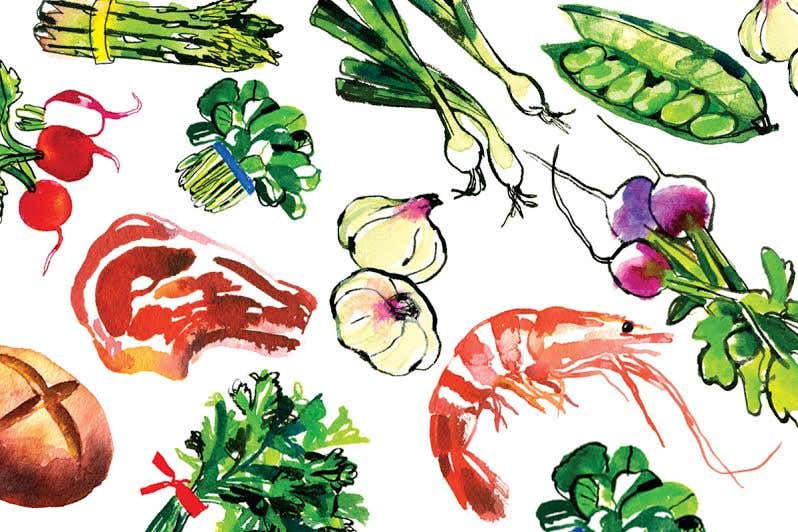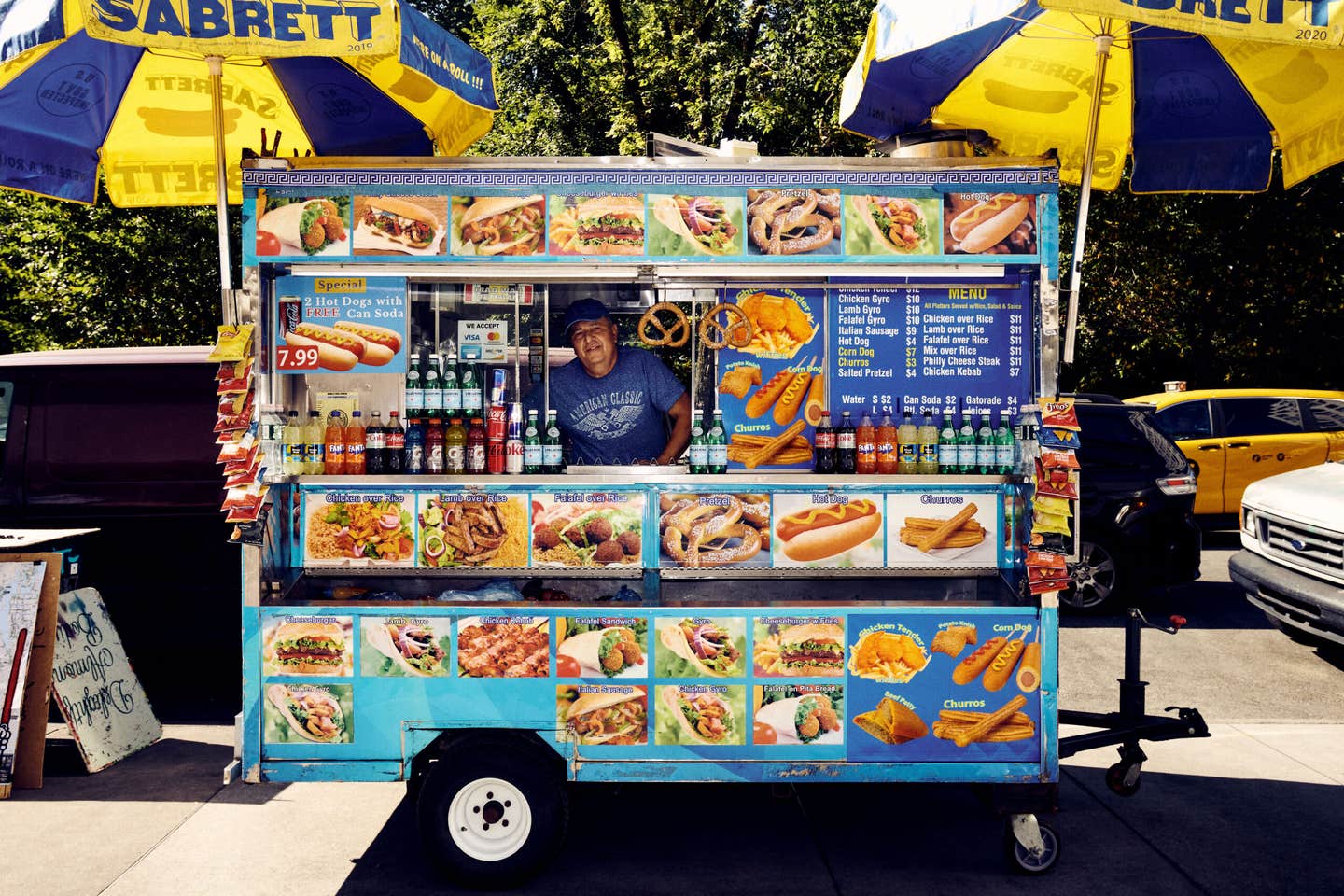
The great soft-ripened cheese called camembert has become such a durable symbol of a bygone France—along with le beret, la baguette, and l'ugly hotel wallpaper—that it comes as something of a shock to learn that the nation still likes to press its collective thumb into such a butterfat-rich cliche. France's five largest cheese factories, in fact, produce 1.5 million of these bleached hockey pucks a day—and camembert remains among the most popular cheeses on plateaux de fromages all over France.
In an effort to disentangle the camembert of mythic import from the rubbery reality, I paid a visit not long ago to Normandy, where the cheese was born. A two-hour drive west from Paris put me in Vimoutiers, a market town on the banks of the river Vie (River of Life), set among fields filled with sated cows munching fat blades of grass. One of the first things you see when you pull off the D579 to enter the town is a statue of the woman who is said to have invented camembert—minus her head. The sight of this broad-hipped Norman peasant lass, decapitated by 29 tons of bombs in 1944, struck me as somewhat ominous at first. I soon realized, however, that a headless statue is as good a symbol as any of the complicated history of France's national cheese.
Here is the official legend, as told by guides at the chief tourist attraction in Vimoutiers, the Musee du Camembert: In 1791 a priest from the Brie region, east of Paris, fleeing from revolutionary sans-culottes (who would have lynched any cassock-wearing cur who didn't shout ''Vive la nation!''), found refuge on a farm in the tiny village of Camembert. Here he met Marie Harel, a hardy Norman dairy maid—and in gratitude for sanctuary, the clergyman showed her how to ladle milk into cylindrical molds, like they did back home in Brie. Voila! Camembert was thus born with the new French nation itself, in a kind of passing of the gastronomic torch from the old, priest-ridden monarchy to the brave new Republic.
There are few problems with this story, unfortunately: First of all, nit-picking food scholars have turned up references to the cheese of Camembert as long ago as 1680. Second, the aforementioned Marie Harel, nee Fontaine, was actually not from Camembert at all but from the nearby village of Crouttes. And third, if Harel had moved to Camembert when (and if) she invented the cheese, why is the Musee du Camembert located in Vimoutiers? (Actually, there's an answer to that last question: The cheese was first sold, and gained its reputation, at the Vimoutiers market.)
Not that the museum isn't worth visiting. For an admission price of 15 francs (about $2.50), you will learn what makes a good camembert: exactly 3.8 pints of milk per cheese, collected exclusively from the cows of Normandy, slowly spooned into cylindrical aluminum or plastic molds, drained, salted, then wrapped in waxed paper and packed in thin poplar-wood boxes. At the museum, you'll also get to see Europe's premier public collection of camembert labels, French and otherwise. My favorites were Le Bambi brand, in which Thumper dribbles a round of camembert beneath his foot, and Le Cow-boy, which features a spur-wearin' galoot making his getaway—across a cactus-filled grassy field—after robbing the Camembert stagecoach. Then there are all those foreign abominations, like genuine pasteurized Danish, Japanese, and Wisconsin camemberts. In summer, for an additional 15 francs, you can conclude your museum visit with a tasting at picnic tables outside, sampling the real stuff, in all its fragrant glory, with bowls of farmhouse cider.
The museum also gets around to explaining the mystery of the statue as well. In 1926 a New Yorker named Joseph Knirim showed up in a Vimoutiers pharmacy proffering a twenty-dollar bill, explaining that he'd come to lay a wreath at the grave of Marie Harel. The exemplary digestibility of camembert, he said, had cured his stomach ailments, and he'd crossed the Atlantic to honor the inventor of this miraculous panacea. Civic elders and the Syndicat des Fabricants du Veritable Camembert de Normandie—the Union of Producers of True Normandy Camembert—recognized a PR godsend when they saw one, and used Knirim's donation as a down payment on a sculptor's impression of a buxom, clog-wearing Madame Harel (there was no contemporary portrait) with a pot of milk on her hip. (Knirim, meanwhile, headed off to Plzen, Czechoslovakia, to pay tribute to pilsner beer. With a diet based on beer and a cheese that's 45 percent butterfat, it is perhaps not surprising that he died shortly after his return to New York.)
The stalwart Harel stood in the middle of the town until that day in 1944 when she became one of 221 victims of misdirected B-26s. But as the New World taketh away, the New World giveth: A decade after the bombing, 400 employees of The Borden Company in Van Wert, Ohio—whose contributions to world civilization include Pizza-Mate, processed cheese in a hermetically sealed plastic bag—donated funds for a lithe, demure replacement for the original, which now stands near the post office in the town square. (It bears approximately the same relationship to the first statue as Walt Disney's cuddly Quasimodo does to Charles Laughton's drooling bell-ringer).
None of this explains, however, why Vimoutiers (pop. 4,700) gets two statues, a museum, and the lion's share of the cheese tourism trade, while Camembert (pop. 185), a heartbreakingly beautiful hilltop village three miles down the road, gets bypassed. For years, the Camembertois have accused the Vimonasteriens of stealing their thunder by telling visitors that there's nothing much to see in the nearby hamlet. In fact, there's now a worthy little information center (shaped like an outsize camembert) between the church and the town hall—and, at a crossroads in front of a tree-trunk-like crucifix, a granite obelisk honoring Marie Harel. Unfortunately, most visitors still just put on the emergency brake, snap a picture of themselves in front of the little red-bordered Camembert sign, and drive off. Which is a shame, really—the town itself is one place where you can be sure of getting the real stuff: ''Camembert de Normandie fermier, fabrique a Camembert''.
In search of just such a cheese, I drove a couple of miles south of Camembert and pulled into farmer Michel Delorme's driveway, scattering a flock of geese, crushing a few windfall apples under tire, and setting a terrier barking. Camembert fermier, or farmhouse camembert, must be produced on the same farm where the milk is collected. It also must be unpasteurized, and hand-ladled into the molds. Ideally, too, it is covered with a downy white crust, which forms after the curdled, salted milk is sprayed with Penicillium candidum.
I bought a round of cheese of exactly this description from Delorme—but I couldn't visit his cheesemaking facility: The hygiene rules of the new united Europe bar visitors from places where cheese is made. Shortly after my visit, in fact, Delorme stopped producing camembert altogether, because implementing the new EU regulations would have been too costly. (He still sells camembert purchased from a local factory and matured at his farm). There is only one producer of camembert fermier left today in the commune of Camembert—a young farmer named François Durand, who makes about two thousand rounds a week.
Leaving Delorme's farm, I pulled over on the side of the road to sample his cheese: As I bit through the crust, into the yellowish ivory of the center, a complex, liquid-solid saltiness coursed through my mouth. This was nothing like the rubbery, bland, foil-wrapped wedges they serve you on TGV bullet trains; this is on the verge of pungency—a somehow palatable condensation of the odors of the local countryside. Whoever invented camembert, it seems, distilled the essence of Normandy in a little wooden box.
Keep Reading
Continue to Next Story










